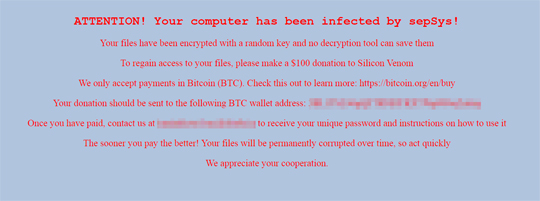Ransom.Win64.SEPSYS.A
Trojan-Ransom.SepSys (Ikarus); Ransom:Win32/SepSys!MTB (Microsoft); Win64/Filecoder.BM trojan (NOD32)
Windows


Threat Type: Ransomware
Destructiveness: No
Encrypted: Yes
In the wild: Yes
OVERVIEW
This Ransomware arrives on a system as a file dropped by other malware or as a file downloaded unknowingly by users when visiting malicious sites.
It encrypts files found in specific folders. It avoids encrypting files with the following file extensions.
TECHNICAL DETAILS
Arrival Details
This Ransomware arrives on a system as a file dropped by other malware or as a file downloaded unknowingly by users when visiting malicious sites.
Installation
This Ransomware adds the following processes:
- powershell.exe -WindowStyle hidden -Command Start-Process -FilePath %ProgramData%\README.html -> opens the ransom note
- reg add HKCU\Software\Microsoft\Windows\CurrentVersion\Run /v Service /t REG_SZ /d %PrograData\README.html
(Note: %ProgramData% is a version of the Program Files folder where any user on a multi-user computer can make changes to programs. This contains application data for all users. This is usually C:\ProgramData on Windows Vista, 7, 8, 8.1, 2008(64-bit), 2012(64-bit) and 10(64-bit), or C:\Documents and Settings\All Users on Windows Server 2003(32-bit), 2000(32-bit) and XP.)
Autostart Technique
This Ransomware adds the following registry entries to enable its automatic execution at every system startup:
HKEY_CURRENT_USER\Software\Microsoft\
Windows\CurrentVersion\Run
Service = "%ProgramData%\README.html"
Other Details
This Ransomware connects to the following URL(s) to get the affected system's IP address:
- http://www.{BLOCKED}.ch
Ransomware Routine
This Ransomware encrypts files found in the following folders:
- %Users%\
It appends the following extension to the file name of the encrypted files:
- .sepsys
It leaves text files that serve as ransom notes containing the following text:
- %ProgramData%\README.html

It avoids encrypting files with the following file extensions:
- .ini
SOLUTION
Step 1
Trend Micro Predictive Machine Learning detects and blocks malware at the first sign of its existence, before it executes on your system. When enabled, your Trend Micro product detects this malware under the following machine learning name:
- Ransom.Win32.TRX.XXPE50FFF034E0002
Step 2
Before doing any scans, Windows 7, Windows 8, Windows 8.1, and Windows 10 users must disable System Restore to allow full scanning of their computers.
Step 3
Note that not all files, folders, and registry keys and entries are installed on your computer during this malware's/spyware's/grayware's execution. This may be due to incomplete installation or other operating system conditions. If you do not find the same files/folders/registry information, please proceed to the next step.
Step 4
Restart in Safe Mode
Step 5
Delete this registry value
Important: Editing the Windows Registry incorrectly can lead to irreversible system malfunction. Please do this step only if you know how or you can ask assistance from your system administrator. Else, check this Microsoft article first before modifying your computer's registry.
- In HKEY_CURRENT_USER\Software\Microsoft\Windows\CurrentVersion\Run
- Service = "%ProgramData%\README.html"
- Service = "%ProgramData%\README.html"
Step 6
Search and delete these files
- %ProgramData%\README.html
Step 7
Restart in normal mode and scan your computer with your Trend Micro product for files detected as Ransom.Win64.SEPSYS.A. If the detected files have already been cleaned, deleted, or quarantined by your Trend Micro product, no further step is required. You may opt to simply delete the quarantined files. Please check this Knowledge Base page for more information.
Step 8
Restore encrypted files from backup.
Did this description help? Tell us how we did.

